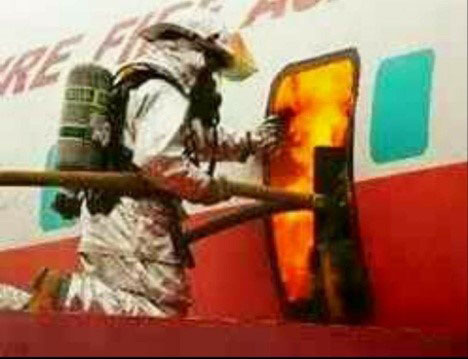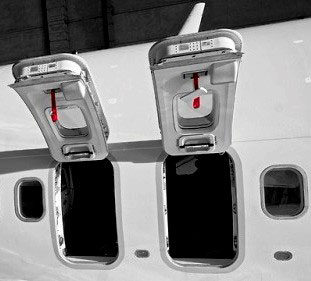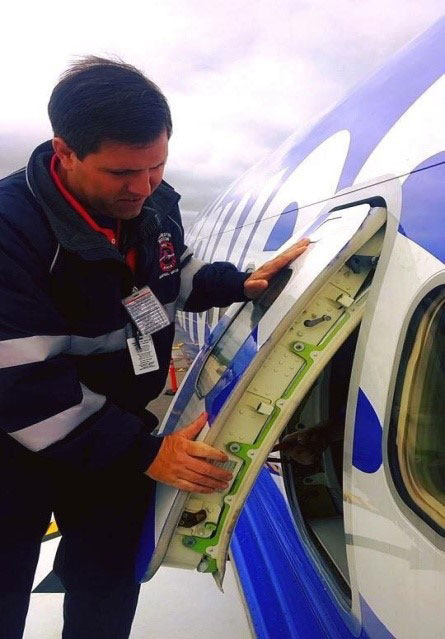Airline passengers know the benefits of the over-the-wing exit each time they board to fly. The flight attendants do an exceptional job during the preflight safety briefing to explain the location and operation of the aircraft exits. Aircraft rescue firefighters often have been educated on the same things, except our focus is primarily based from looking at them from the outside.

A View from the Wing
Firefighters should have an understanding of normal, service, and emergency exit doors. Many of these doors are designed to be a “plug-type” door. This is probably one of the most common in the industry but times are changing. Today I want to take a moment to provide some insight on a newer version of the plug-type over-the-wing exit. That is the hinged gull-wing, multilock door. The airport I am charged to protect has quite a few of these doors coming and going on a daily basis. It is very important that the members of the ARFF department understand how to identify these newer doors and how they operate so they can maintain a high level of operational readiness and firefighter safety.

The Boeing 737 Next Generation aircraft commonly abbreviated as “737NG” is the name given to the 600, 700, 800, and 900 series of the Boeing 737 airliners. It is the third generation of the 737 line and follows the 737 Classic series of 300, 400, and 500 models that date back to the 1980s. They are short- to medium-range, narrow-body aircraft powered by two engines.
The Boeing 737 NG has been in production since 1996 and includes four variants that can seat between 110 and 210 passengers. As of 2017, more than 7,000 NG aircraft have been ordered and delivered. The Boeing 737 MAX was designed and is produced as the fourth generation 737. As of June 2018, the Boeing 737 MAX has received more than 4,600 orders.

The Boeing 737 Next Generation (NG) Series
Big changes came with the NG in the over-the-wing emergency exit door configuration. The airframe construction was beefed up to handle a rapid response emergency hatch, and the door design itself is completely different than in the past 737 Classic Series construction. The over-wing exit doors on the 737 NG Series are equipped with electronic locks that engage only when the plane is in flight. If the plane slows to a near stop or loses altitude, the door will unlock. Also, since the locks require electricity to hold the door closed, a loss of aircraft power will return them to the unlocked position. Flight attendants sometimes are required to guard these doors based on any minor malfunction with the system. The good news is that a malfunctioning emergency door lock has never prevented escape in a true aircraft emergency.
Why the Change in Design?
The 737 NG over-the-wing exits were redesigned in light of human factor research—in particular, the Manchester UK Air Disaster, which involved a British Air Tours Boeing 737-236, where passengers demonstrated difficulty in opening over-the-wing hatch-style exits by passengers during times of duress. The benefits of the 737 NG design is it is exceptionally easy to open. The only step is to pull down on the red handle. The door itself will swing out. Passengers sometimes get confused with the traditional hatch design, thinking it is supposed to open inward, so they pull on the armrest. The NG design allows the exit to swing out without any effort post pulling the red handle. There is no need for a passenger to carry the weight of the hatch, which can be very heavy and awkward in size (35-45 pounds).
The exit itself is “self disposing”—meaning the next generation over-the-wing exit swings out and upward from the aircraft, thus eliminating confusion on where to place the emergency exit window of previous generations. History has proven that the older emergency exit window can block the passenger emergency egress path. This is because the older emergency window design required the hatch to fall inside the passenger compartment first before manually clearing the opening. For a quick reference to the operation, view this video clip of the 737NG training video: https://youtu.be/QMsIsNc905o

How the System Works
During my research into the Boeing 737 NG System, it was identified that each side of the axle has one electronic sensor. That means there are two sensors per landing gear on a 737, and six sensors to confirm weight on the wheels. If one of those sensors fails, the pilots will get a warning or an electronic fault in the cockpit. The engineered design has a redundant monitoring system by looking at weight on all the wheels. So if one main gear’s dual sensors was entirely faulty, the system would still unlock because it senses the weight on the other landing gear sensors.
Emergency Exit Doors
During NORMAL INFLIGHT OPERATIONS the flight locks are engaged when either engine is more than 50 percent powered and three or more entry/service doors are closed. During NORMAL ON GROUND OPERATIONS, the flight locks will be disengaged when either thrust lever is set below approximately 53 degrees and the air/ground sensors are in the minimum, like we mentioned before. Most airline policies operate with concern, therefore if one of them has failed, then the aircraft needs further maintenance before flight operations resume.

Concerns for ARFF Operations
Progressive fireground operations require ARFF firefighters to open any doors or windows that aren’t currently open and in operation. The more openings we can create, the more people we can evacuate in a timely manner. The hazard that many don’t understand is that the 737 NG design requires firefighters to be cautious of the rapid opening action of the door. This may require you to slow down the movement of the door as it springs upward or positioning your body to the left or the right of the opening and letting the door swing without resistance. I have to caution regarding the latter, as the release mechanism is located toward the top of the window hatch. When firefighters do not control the speed of the emergency over-the-wing hatch, the firefighters may be hit by the window, causing loss of balance (combined with the possibility of AFFF foam being on the wing from fire control) or the possibility of traumatic injury to your torso, head, and neck from being knocked off the wing. More specifically, your arm and shoulders are susceptible to being struck while directly inline and above the majority of the hatch itself.
FAR 139.319 (i)(2)(vii) requires all aircraft rescue firefighters to train annually on emergency aircraft evacuation assistance. If your airport is being serviced by the Boeing 737 NG series and has a maintenance hub, I suggest making contact with the facility for hands-on (psychomotor skills) for this specific over-the-wing concern. We have learned from the aircraft maintenance personnel that if you operate these without having physical door control, ARFF personnel can cause undue damage to the door itself, the hinges, and/or the fuselage from rapid uncontrolled opening of the door. It can essentially slap the fuselage. Also when opening emergency exit doors, they must be recertified prior to that aircraft taking flight, so ARFF firefighters should perform this type of training in the presence of a certified maintenance technician.
In Conclusion
The operational effectiveness of an aircraft rescue firefighter has a direct correlation to the amount of quality training he receives. Top quality training officers provide the knowledge, skills, and abilities (KSAs) required to perform these tasks that will ultimately make a difference in the flying public’s life. But more importantly, a good training officer will make sure that all ARFF personnel understand how to identify this Next Generation design, the feature(s) thereof, and any hazards associated with working on that wing during ARFF emergency fireground operation. Stay safe my friends.
WILLIAM GREENWOOD is a 25-year veteran of the fire service. He is currently the assistant fire chief of training at the Manchester-Boston Regional Airport. He is a senior staff instructor for the New Hampshire Fire Academy and owns FETC Services, which provides advanced firefighter and leadership training/consultation services. He is also a national speaker for FDIC International and has been published in Fire Engineering and FireRescue.

